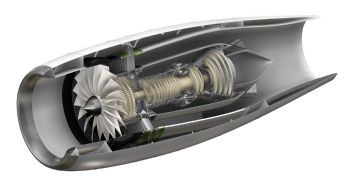
@GE_Reports @Bombardier #composites #engineering #manufacturing The new Passport engine for the Bombardier Global 7000 and Global 8000 series aircraft incorporates ceramic matrix composite (CMC) material and a unique blade surface that GE officials say will improve performance, reduce fuel burn, and enhance durability.
Brad Mottier — vice-president and general manager of the Business & General Aviation and Integrated Systems organisation — said: “GE Aviation invests close to $1 billion annually on research and development of advanced technologies and materials, and the Passport engine is benefitting from these efforts. It will be the first non-military engine to use Oxide-Oxide CMCs.”
GE Aviation began developing Ox-Ox in the late 1980s as part of its CMC research efforts. Ox-Ox was introduced for F414 exhaust seals in 2011 to improve durability.
For the Passport engine, the Ox-Ox CMC material will be used on three parts: exhaust mixer, centre-body, and core cowls. The lightweight material is resistant to high temperatures found in the exhaust area and will enhance the engine’s durability, as well as reduce fuel consumption.
Furthermore, the Passport’s high-pressure compressor blades and blisks feature a unique super-finish surface that makes them four-times smoother than traditional blades. This super-finish allows the air to pass more efficiently over the blades, resulting in lower fuel consumption.
The surface finish also allows the blades to better retain their efficiency and performance by creating a layer of air, which guards against contaminants that might stick to traditional blades.